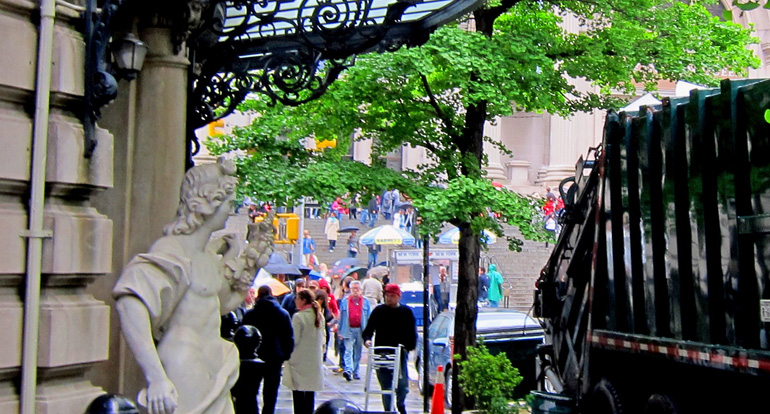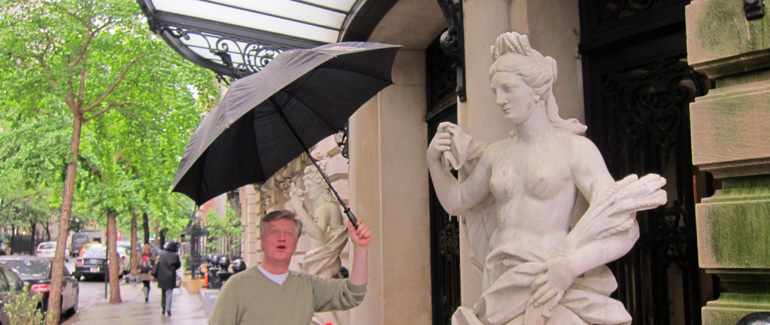Museum Note:
Talk About Bad Taste
17 May 2011
Never, ever, have I found the Metropolitan Museum of Art as packed with people as it was today. Never! It was almost impossible to cross the Great Hall, so thick were the lines snaking back from the ticket counters. (The advantage of membership at any level is the convenience of getting an entry pin from the members’ desk, just outside the gift shop, without delay.) Upstairs, the line of visitors waiting to see the Alexander McQueen show stretched the full length of the Chamber of Horrors, all the way down to the Assyrians. I’ve never seen such a line!
Happily, Ray Soleil and I were interested in the Eighteenth-Century pastel portraits. No crowds there. Lots of lovely things, but lots of not-so-lovely things as well, including one piece of rather dreadful kitsch by Anton Mengs, the bust of an éphèbe with rancidly liquid eyes and a crown of roses — the template for a thousand ghastly late-Nineteenth Century candy boxes. Most of the beautiful things are French — a Nattier, some Coypels, a few Quentin de la Tours — but what caught my interest most was a pastel by Gainsborough, who didn’t do much in the medium. It’s a small, half-length portrait of the fourth Duchess of Marlborough. Her head and hair are finely modeled; her dress and lace shawl are a riot of impressionistic strokes. In reproduction — the Museum Bulletin for Spring 2011 is effectively this exhibition’s catalogue — the picture has an anemic air, because the palette is almost that of grisaille, with shades of blue and pink emerging only after your eyes adjust (the duchess’s face, it must be said, is grey); but in the life it is a formidably attractive portrait.
Among the Quentin de la Tours, there was a sketch for his portrait of Louis XV — a sketch that is fairly finished enough for most purposes. What’s striking about the artist’s portraits of the king is the care that they take to show the royal five-o’clock shadow. This can only be meant to reassure us that beneath the powder and the finery there pulses what Fossil calls a manly man. We are certainly not supposed to think that Louis needed a shave. The effect is quite indecent.
On our way to the pastels, Ray and I stopped in at the Rooms With a View show, which occupies a small quarter of the old-master special exhibition space. Like most shows with a theme, this one features works of widely varying quality, with the result that the really good things stand out all on their own, without your having to know anything about them. (If you want to know how great Mozart is, listen to Salieri or Gluck.) It’s no surprise to cross the room, drawn by a dream of romantic concision, and find that it’s the work of Caspar David Friedrich.
Two of the pictures are views from the Villa Medici — which still accommodates, according to Wikipedia, the French Academy in Rome — that feature St Peter’s and Castel Sant’ Angelo off in the distance, the Castel looking rather small in both. One is a painting (1817) by Jean Alaux, and one is a watercolor (1863) by Constant Moyaux. Both artists were Prix de Rome winners. We wondered what had become of the Prize, and were distressed to learn later that André Malraux put an end to it in 1968, that awful year for the French establishment. “Stupid,” said Ray, when I told him.
As you can see, those horrible concrete garden statues are still gracing the portal of the Duke-Semans Mansion at 1009 Fifth Avenue, right across the street from and a smack in the ey of the Museum. It would probably be going to far to say that the house is currently being gutted, but evidence suggests that the new owner has contracted for an extensive renovation. Since the statues of Feebus and Phlora were not the first things to go, we hope that they’ll be the last. We will miss them, mostly because, when they’re gone, no one will believe us when we say that they were ever there.


